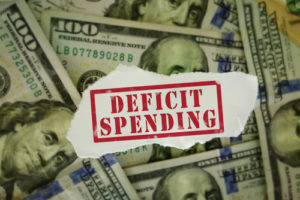
Income tax was first introduced to England in 1799. Napoleon was planning to invade and we had an (allegedly) one-off whip round to raise money to fight.
It was controversial at the time, not just handing the tax over, but it was seen as a stunning invasion of privacy, since people had to declare what they had in order to work out how much they owed. It didn’t take long to hit on the idea of deducting tax at source (1803). The original rate was 10% but only applied to a small percentage of the wealthiest people.
Skipping forward to 1914 the rate stood at 6%, but following another war it was 30% by the end of 1918. The number of people paying it also tripled from just over 1 million to 3 million, and it started to look more like the system we would recognise today.
Along came the Second World War and we decided the war effort would again be paid for partly through higher taxation. The rate increased as well as the number of people paying – rising to 15 million in 1944.
The government also funded the Second World War with debt which rose to around 240% of GDP. During the war, Keynes famously said “anything we can actually do we can afford”.
Received wisdom is that we (mostly) work hard to earn money which enables us to pay tax to jointly fund the government to build roads, schools, hospitals and other things we all share and benefit from. We have notions of fairness around this and who pays what and why. We talk a lot about “taxpayers’ money” often with some moral view of what it is being spent on.
On the debt side, we usually talk about government deficits in negative terms. They have “too much” debt which needs to be reined in, balance the books, tighten our belts, live within our means – all these personal finance parallels and metaphors. We sometimes worry about our children having to pay it back at some point.
We recently ran a large, real time, hopefully relatable experiment on all this during Covid. The UK and most other developed market governments ran up huge deficits. This money went in some cases directly to the private sector and to consumers, who largely spent it, creating more private sector demand.
Covid was an extreme case of course, and we can argue about the amounts involved, but the general idea of it is sound enough. There wasn’t much option to increase income tax during Covid. Providing last resort, emergency liquidity is part of the government’s role and purpose (or I suppose more strictly the Bank of England in response to what the government does).
More normally without Covid, it makes sense to have a deficit if the country is a net saver or importer – which the UK is. If the private sector buys more than it sells, it needs to get the money from somewhere. Or in other words, while we tend to talk negatively about the government deficit, it is a private sector surplus on the other side of the trade.
This leads to an alternative view. Taxation isn’t really about funding the government, it is more about keeping inflation under control. The Bank of England is trying to keep the amount of money created in the economy consistent with low and stable inflation and the government deficit is part of this.
Like a commercial bank, the government creates money through deficit spending. When you take a loan from a bank, they don’t take someone else’s deposit and lend it to you, they more simply credit the amount to your account. Both sides of the bank’s balance sheet expand accordingly.
Some of the above leads people into conspiracy theory rabbit holes, which nearly stopped me writing it. They jump to the slightly wild conclusion that it all means that the government can and should print as much money as it can without consequences or not tax us at all.
In much the same way there is plenty of evidence the earth is round, there is plenty of real-world evidence for how this works. Liz Truss ran a second large, real time, hopefully relatable experiment on it.
Her budget would have been highly inflationary and the bond market reacted accordingly – widening yields, which means demanding a higher rate of return. They know they will always get their 100p back, but what is that 100p going to be worth in ten years’ time?
The US bond market has reacted to the second Trump presidency with a particularly sharp rise in bond yields at the long end. This usually means strong nominal growth is expected or uncertainty has increased and the term premium has gone up.
Conspiracy theories are not needed to explain this. The two most important words in the Keynes quote are “actually do”. We can fight wars, muddle through a pandemic, build HS2 even, if we wanted to.
The government can’t borrow as much as it wants, but it isn’t because of the usual framing around “affordability”, or shadowy institutional forces in the bond market or the Bank of England that Liz Truss (still) likes to talk about.
The limits – and I think this is what Keynes was getting at – are production and consumption. There is plenty of both during wars, and it is rational for a government to increase its balance sheet in times of stress like this, or a pandemic. Any government is going to do the same thing if we find ourselves there again in the future.
Robert Fullerton – Senior Research Analyst

FPC24205
All charts and data sourced from FactSet
Hawksmoor Investment Management Limited is authorised and regulated by the Financial Conduct Authority (www.fca.org.uk) with its registered office at 2nd Floor Stratus House, Emperor Way, Exeter Business Park, Exeter, Devon EX1 3QS. This document does not constitute an offer or invitation to any person in respect of the securities or funds described, nor should its content be interpreted as investment or tax advice for which you should consult your independent financial adviser and or accountant. The information and opinions it contains have been compiled or arrived at from sources believed to be reliable at the time and are given in good faith, but no representation is made as to their accuracy, completeness or correctness. The editorial content is the personal opinion of Robert Fullerton, Senior Research Analyst. Other opinions expressed in this document, whether in general or both on the performance of individual securities and in a wider economic context, represent the views of Hawksmoor at the time of preparation and may be subject to change. Past performance is not a guide to future performance. The value of an investment and any income from it can fall as well as rise as a result of market and currency fluctuations. You may not get back the amount you originally invested. Currency exchange rates may affect the value of investments.
